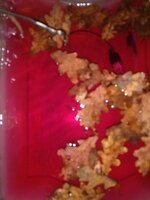Barbara Turner
Member
Hi All
I noticed a white ulcer on the mouth of one of my neons, a few days later I bought seachem paraguard as I believed it to be a fungal infection.
I put 2 litres of water in a large clear bag medicated it and left him floating in it for a hour.. (didn't seem bothered)
I've done this a collection of times but it's now spread to half the neon tetras. Although it hasn't killed any of them.
There all still feeding well and pretty much un affected. I've read online it could be columnaris, but it doesn't seem to be spreading to the cat fish or ember tetras and there still alive.
Tank is heavily planted and has a large number of cherry shrimps. I've also ordered a new heater so I should be able to setup a better quarantine tank.

I noticed a white ulcer on the mouth of one of my neons, a few days later I bought seachem paraguard as I believed it to be a fungal infection.
I put 2 litres of water in a large clear bag medicated it and left him floating in it for a hour.. (didn't seem bothered)
I've done this a collection of times but it's now spread to half the neon tetras. Although it hasn't killed any of them.
There all still feeding well and pretty much un affected. I've read online it could be columnaris, but it doesn't seem to be spreading to the cat fish or ember tetras and there still alive.
Tank is heavily planted and has a large number of cherry shrimps. I've also ordered a new heater so I should be able to setup a better quarantine tank.



